Objective: To assess whether the eye-tracking approach of the RECOGNeyes game has potential therapeutic benefits for children with neurodevelopmental disorders, in particular attention-deficit/hyperactivity disorder (ADHD). RECOGNeyes is a computer game that is played using the eyes as the game controller. The rationale behind the game is that individuals with ADHD have an underdeveloped attention control system. This attention control system is underdeveloped not because they lack this capacity but because this ability has not been sufficiently developed. The game was designed as an intervention for training visual attention in ADHD.
Methods: The sample included 28 children aged 8-15 years (18 aged < 12 y and 10 aged ≥ 12 y) previously diagnosed with ADHD (DSM-5 criteria). The participants were randomly divided into 2 groups. The experimental group played RECOGNeyes with eye-tracker for 3 weeks (3 times/week) at home, while the control group played the game using the mouse. Different attentional parameters were assessed before and after training. The study was conducted from January 2018-June 2018.
Results: Participants from the eye-tracker group showed an improvement posttest compared to pretest in impulsivity (P = .0067), reaction time (P < .0001), and fixation gaze control (P < .0001). No changes were found in mouse control between pretest and posttest assessments.
Conclusion: RECOGNeyes is a child-friendly, interactive game combined with eye-tracking technology that seems to provide an improvement in the visual attention system, which is especially indicated for ADHD patients. This game might be used as an alternative to pharmacologic therapy and may provide new insights into the treatment of ADHD.’ ‹
Novel Interactive Eye-Tracking Game for Training Attention
in Children With Attention-Deficit/Hyperactivity Disorder
ABSTRACT
Objective: To assess whether the eye-tracking approach of the RECOGNeyes game has potential therapeutic benefits for children with neurodevelopmental disorders, in particular attention-deficit/hyperactivity disorder (ADHD). RECOGNeyes is a computer game that is played using the eyes as the game controller. The rationale behind the game is that individuals with ADHD have an underdeveloped attention control system. This attention control system is underdeveloped not because they lack this capacity but because this ability has not been sufficiently developed. The game was designed as an intervention for training visual attention in ADHD.
Methods: The sample included 28 children aged 8–15 years (18 aged < 12 y and 10 aged ≥ 12 y) previously diagnosed with ADHD (DSM-5 criteria). The participants were randomly divided into 2 groups. The experimental group played RECOGNeyes with eye-tracker for 3 weeks (3 times/week) at home, while the control group played the game using the mouse. Different attentional parameters were assessed before and after training. The study was conducted from January 2018–June 2018.
Results: Participants from the eye-tracker group showed an improvement posttest compared to pretest in impulsivity (P = .0067), reaction time (P < .0001), and fixation gaze control (P < .0001). No changes were found in mouse control between pretest and posttest assessments.
Conclusion: RECOGNeyes is a child-friendly, interactive game combined with eye-tracking technology that seems to provide an improvement in the visual attention system, which is especially indicated for ADHD patients. This game might be used as an alternative to pharmacologic therapy and may provide new insights into the treatment of ADHD.
Prim Care Companion CNS Disord 2019;21(4):19m02428
To cite: García-Baos A, D’Amelio T, Oliveira I, et al. Novel interactive eye-tracking game for training attention in children with attention-deficit/hyperactivity disorder. Prim Care Companion CNS Disord. 2019;21(4):19m02428.
To share: https://doi.org/10.4088/PCC.19m02428
© Copyright 2019 Physicians Postgraduate Press, Inc.
aDepartment of Experimental Science and Health, University Pompeu Fabra, Barcelona, Spain
bDepartment of R&D, Braingaze SL, Mataró, Spain
cDepartment of Neurofisiología, Facultad de Psicología, Universidad de Buenos Aires, Ciudad Autónoma de Buenos Aires, Argentina
dDepartment of Biomedical Engineering, School of Engineering, Trinity College, Dublin, Ireland
eDivision of Psychiatry and Applied Psychology, School of Medicine, University of Nottingham, Nottingham, United Kingdom
fTDAH Vallés, Sabadell, Spain
gBinding, Barcelona, Spain
hICREA, Barcelona, Spain
iInstituto de Neurociencias, Barcelona, Spain
jDepartment of Cognition, Development and Educational Psychology, Faculty of Psychology, University of Barcelona, Barcelona, Spain
*Corresponding author: Hans Supèr, PhD, Department of Cognition, Development and Educational Psychology, University of Barcelona, Vall d Hebron 171, Barcelona 08350, Spain ([email protected]).
Attention-deficit/hyperactivity disorder (ADHD) is one of the most common neurodevelopmental disorders.1,2 The current treatment for ADHD includes medication, psychotherapy, education, or a combination of treatments.3 ADHD is the result of a dysregulation of the catecholaminergic pathways,4–6 and treatment with drugs is thought to stimulate the release and inhibit uptake of catecholamines, thereby reducing symptomatology in ADHD.
Despite the large effect sizes and the success of pharmaceutical treatments in ADHD, there are a number of reasons to identify alternative treatments that can be combined with pharmaceuticals. Pharmaceutical medication may not be equally effective across different ADHD subgroups. Approximately 73%–75% of children and adolescents with ADHD are reported to receive pharmacologic treatment, and only 58% are good responders.7 Also, there is a reluctance to prescribe medication to young children. Possible side effects of medication are problematic and include trouble falling asleep, loss of appetite, headaches, dry mouth, nausea, tics, dizziness, mood swings, and reduced creativity. There are also reports that medication can reduce a child’s height growth8 and that it may have a disproportionately larger effect on symptoms than on cognitive deficits.9
Hence, there is a need to develop alternative therapies such as cognitive training for ADHD patients. The use of engaging video games may be an effective way to deliver cognitive training. To date, the use of new technologies has progressively been applied in several mental disorders, including obsessive-compulsive disorders,10 schizophrenia,11 eating disorders,12 addictive behaviors,13 and anxiety disorders.14 Previous pilot studies have suggested that computer games in general could be helpful as additional interventions in areas such as schizophrenia,11 anxiety disorders,15 and ADHD.16
The oculomotor system is intimately connected to the attention system of the brain. The direction of gaze provides a proxy for attention, and as gaze direction is determined by muscular movements, the degree of gaze stability may also be a measure of hyperactivity. Eye movements also provide a direct measure of inhibitory motor control. By monitoring eye movements, we can observe participants’ attempts to engage in conscious control over unwanted, prepotent, and reflexive gaze behavior.
RECOGNeyes is a computer game designed by researchers at the University of Nottingham to train attention in people with ADHD.17 The game is played using the eyes as the game controller. Theoretically, as players advance in the game, they learn to control different aspects of their visual attention system. The game isolates specific aspects of visual attention in a unique manner, and it is immediately evident to players that they must carefully control their attention if they wish to succeed. To support learning, the game has 2 main aspects: (1) players receive continuous immediate feedback on their performance while playing the game and (2) the difficulty of the game continually changes in response to a player’s performance to scaffold the development of the targeted skills. The aim of the current study was to evaluate the impact of training with RECOGNeyes on objective attentional parameters and whether it is an attractive game to play among children with ADHD.
METHODS
Participants and Study Design
The sample of the current study included 28 individuals (18 boys and 10 girls) aged 8–15 years (mean [SD] = 11.05 [2.54] years). All of the participants were diagnosed with ADHD (DSM-5 criteria) prior to the study. Seven participants had comorbid dyslexia, and 2 had a learning disability. Participants with autism spectrum disorder were excluded. Informed consent for all participants was obtained from a parental guardian. The study was conducted from January 2018–June 2018.
The 28 participants were randomly separated into 2 groups: experimental group and age-matched control group. The groups were also balanced in terms of comorbidities. The experimental group played RECOGNeyes using the eye tracker (EyeX, Tobii, Stockholm, Sweden), and the control group played using the mouse. The difference in game input—eye movements versus mouse movements—was the only difference between game versions. Both groups played RECOGNeyes for 3 weeks in 1 of 2 game versions (Figure 1) 3 times per week for 30 minutes (9 hours total). The efficacy of the training was evaluated by comparing pre- and posttraining performance on 2 attention tasks.
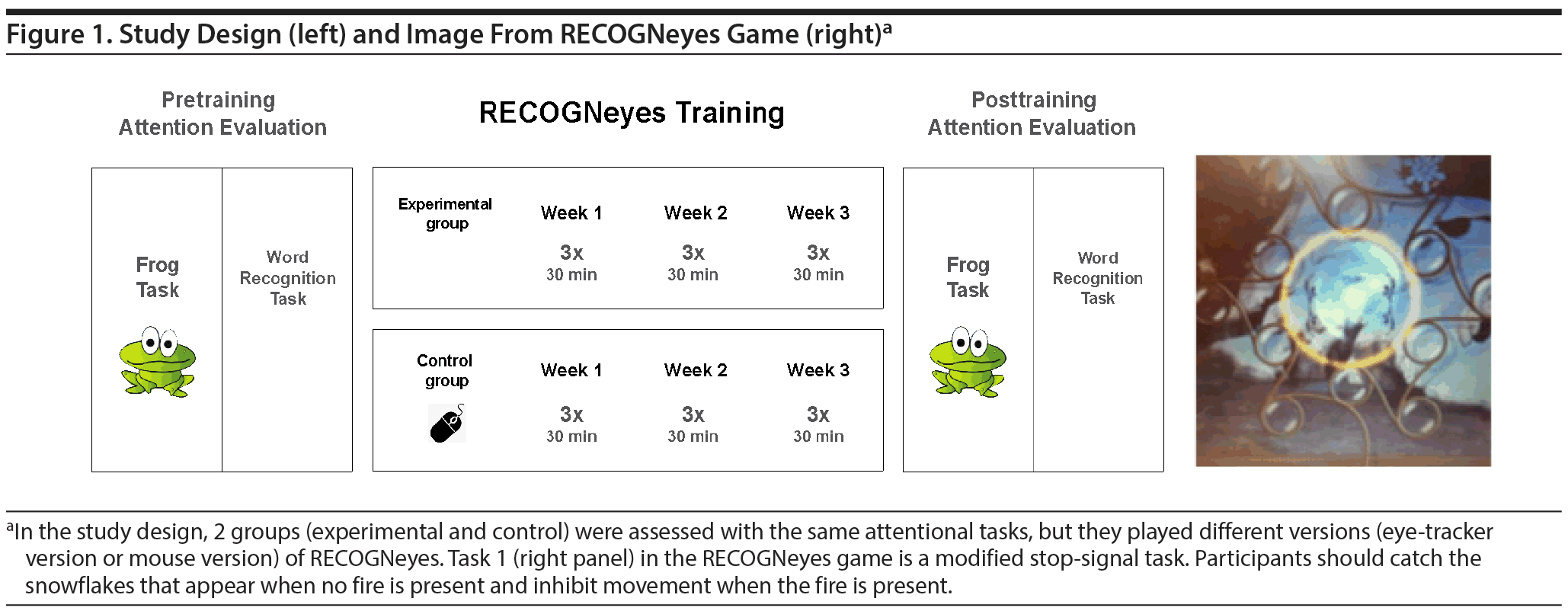
RECOGNeyes
The study was home based. Families were provided a laptop with the game installed and an eye tracker or mouse to play RECOGNeyes. Two versions of RECOGNeyes were created: one in which the game is played using a mouse and an eye-tracking version in which the player’s eyes act as the game controller. A brief automated calibration must be completed each time before using the eye-tracking version. The game has 6 subgames, all of which involve trying to catch snowflakes while avoiding getting caught by fire (see Figure 1).
Tasks and Parameters Assessed
Following training, participants completed a usability and enjoyability questionnaire. At pre- and posttraining assessment sessions, participants completed 2 attention assessment tasks taken from the BGaze system (Braingaze SL, Barcelona, Spain): the frog task and the word recognition task.
The frog task was developed to support ADHD diagnosis18 and consists of 120 trials. Participants first fix their gaze on a frog that appears in the center of the screen. A fish or tadpole appears to the right or left of the frog. When a tadpole appears, they must press a button but refrain from pressing when a fish appears. While performing the task, eye movements are recorded by another eye tracker (X2-30, Tobii, Stockholm, Sweden). Once the task is finished, a report is generated that includes the participant’s performance and different ocular parameters that are used as objective measures to support clinical ADHD diagnosis.18 The parameters are as follows:
- Probability of ADHD: Displays the likelihood of having ADHD and is based on changes in the angle of eye vergence responses.
- Severity of ADHD: Shows the severity of the disorder based on changes in the angle of eye vergence responses.
- Hyperactivity index: The size of the gaze fixation area around the frog during the task and is a function of the level of hyperactivity.
- Impulsivity index: The number of saccadic movements toward the tadpole or fish stimuli.
- Performance parameters: The number of errors (omissions and commissions) and the reaction time.
In addition to these BGaze parameters, we calculated the number and duration of gaze fixations at the central frog during the task.
The word recognition task was developed to support the diagnosis of reading difficulties. The computer-based paradigm has 120 trials. Participants must detect words displayed at the center of the screen among scrambled words. The words are considered as long (≥ 6 letters) or short (< 6) words. Participants should press a button when a word is displayed and withhold responding when a scrambled word is presented. During the task, eye position is recorded. Once the task is finished, a report is generated that includes the following parameters:
- Dyslexia index: Represents the likelihood of having reading difficulties based on changes in the angle of eye vergence responses.
- Performance parameters: The number of errors (omissions and commissions) and the reaction time.
In addition to these BGaze parameters, we calculated the number and duration of gaze fixations during the word recognition task.
A questionnaire assessing the usability and enjoyability of the RECOGNeyes game was completed by all participants. A 3-point scale was used for all questions: yes, no, and no opinion/normal. The usability questions asked how difficult and how challenging the user found the tasks, and the enjoyability questionnaire asked participants whether they liked the game or not.
All parameters were analyzed using 2-way analysis of variance (ANOVA) with the factors “significant group” (eye tracker versus mouse group) and “time point” (pre- or posttesting). Tukey’s post hoc analysis of significant ANOVA measures was analyzed to display multiple comparisons. In some cases, a Wilcoxon sign-rank test was conducted to compare both conditions (eye tracker and mouse on pretest and posttest measures). Additionally, Mann-Whitney test was used to evaluate group differences on pretest measures to assess baseline differences. The statistical analyses were conducted in GraphPad Prism (version 6). Statistical significance was set at P ≤ .05 for all analyses.
Descriptive analyses were used for the usability and enjoyability questionnaire. Data were grouped according to the age of the participant: < 12 years of age (18 participants) and ≥ 12 years of age (10 participants).
RESULTS
Frog Task
Groups did not differ in probability of ADHD (F1,58 = 0.065, P = .799), severity (F1,58 = 0.5, P = .482), hyperactivity (F1,58 = 0.643, P = .436), and amount of errors (commissions and omissions) (F1,58 = 1.832, P = .181). Impulsivity did not show significant differences between groups (F1,58 = 2.076, P = .155). However, impulsivity showed significant differences between pretest and posttest in the eye-tracker group (P = .0067), whereas there were no significant differences in the mouse group (P = .3349). Additionally, pretests of both groups did not significantly differ (P = .6585) (Figure 2A–C).
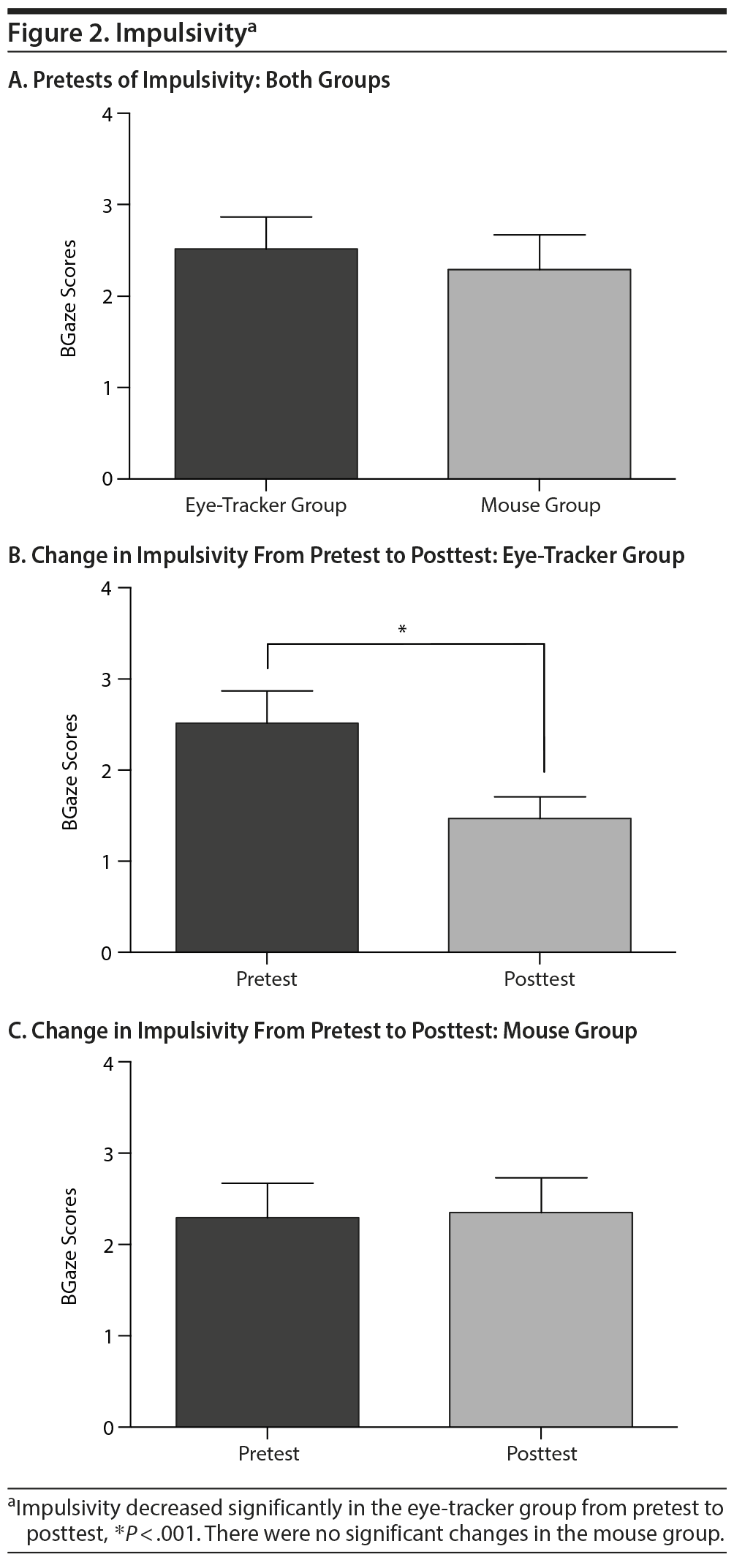
The number of fixations and duration of fixations were assessed for the frog task. For number of fixations, significant group (experimental versus control) and time point (before and after assessment) differences were observed (F1,930 = 6.015, P = .0144; F1,930 = 10.23, P = .0014, respectively). A significant group-by-time point interaction effect was also observed (F1,930 = 5.553, P = .0187). Post hoc analysis revealed that the eye-tracker group significantly decreased the number of fixations posttest compared to pretest (P < .01), while in the mouse group, there were no significant changes between pretest and posttest. Moreover, analysis revealed that the eye-tracker group made a significantly smaller number of fixations posttest compared to the mouse group (P < .01) (Figure 3A). This effect was not observed pretest.
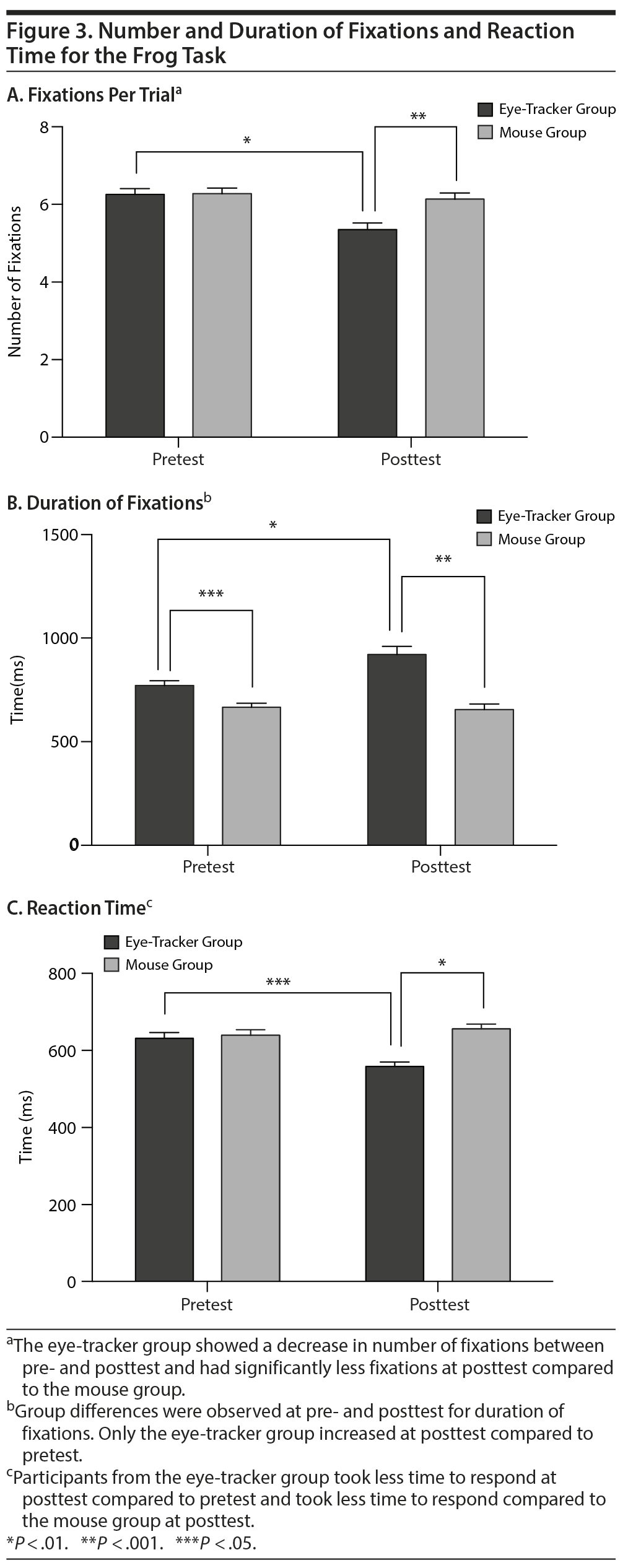
For duration of fixations on the frog task, significant group and time point differences were observed (F1,930 = 45.93, P = .0001; F1,930 = 6.554, P = .0106, respectively). A significant group-by-time point interaction effect was also observed (F1,930 = 8.49, P = .0037). The post hoc analysis revealed group differences at pretest (P < .05) and posttest (P < .0001), with the eye-tracker group demonstrating greater duration of fixations compared to the mouse group at both time points. The eye-tracker group, but not the mouse group, increased the duration of fixations posttest on the frog test compared to pretest (P < .01) (Figure 3B).
Reaction time was also assessed for the frog task. Significant group differences were observed (F1,665 = 11.69, P = .0007). A significant group-by-time point interaction effect was also observed (F1,665 = 8.465, P = .0037). Post hoc analysis displayed significant differences at posttest (P < .0001), with the eye-tracker group taking less time to respond. Post hoc analysis also showed that there were significant differences between pretest and posttest in the eye-tracker group (P < .05), while there were no differences in the mouse group (Figure 3C).
Word Recognition Task
Groups did not differ in probability of dyslexia (F1,44 = 0.189, P = .666) and amount of right words (short right words: F1,44 = 1.494, P = .228; long right words: F1,44 = 0.853, P = .361). The number of fixations and the fixation duration for long words did not differ between groups (F1,567 = 1.102, P = .294; F1,567 = 2.286, P = .1311, respectively). However, ANOVA analysis of the number of fixations on short words showed significant differences in time point as well as significant group-by-time point interaction (F1,562 = 6.522, P = .0109; F1,562 = 6.77, P = .0095, respectively). Post hoc analysis revealed a higher number of fixations for the eye-tracker group (P < .05) during pretesting. The mouse group did not differ between pretest and posttest, while the number of fixations decreased significantly in the eye-tracker group at posttest compared to pretest (P < .05) (Figure 4A). For the duration of fixations on short words, ANOVA analysis revealed significant differences between groups due to the time point and its interaction with the significant group factor (F1,562 = 4.705, P = .305; F1,562 = 12.09, P = .0005, respectively). Post hoc analysis revealed that the baseline was not equal. A higher duration of fixations on short words at pretest was found in the mouse group (P < .001). The duration of fixations increased significantly in the eye-tracker group, but not the mouse group, at posttest compared to pretest (P < .01) (Figure 4B).
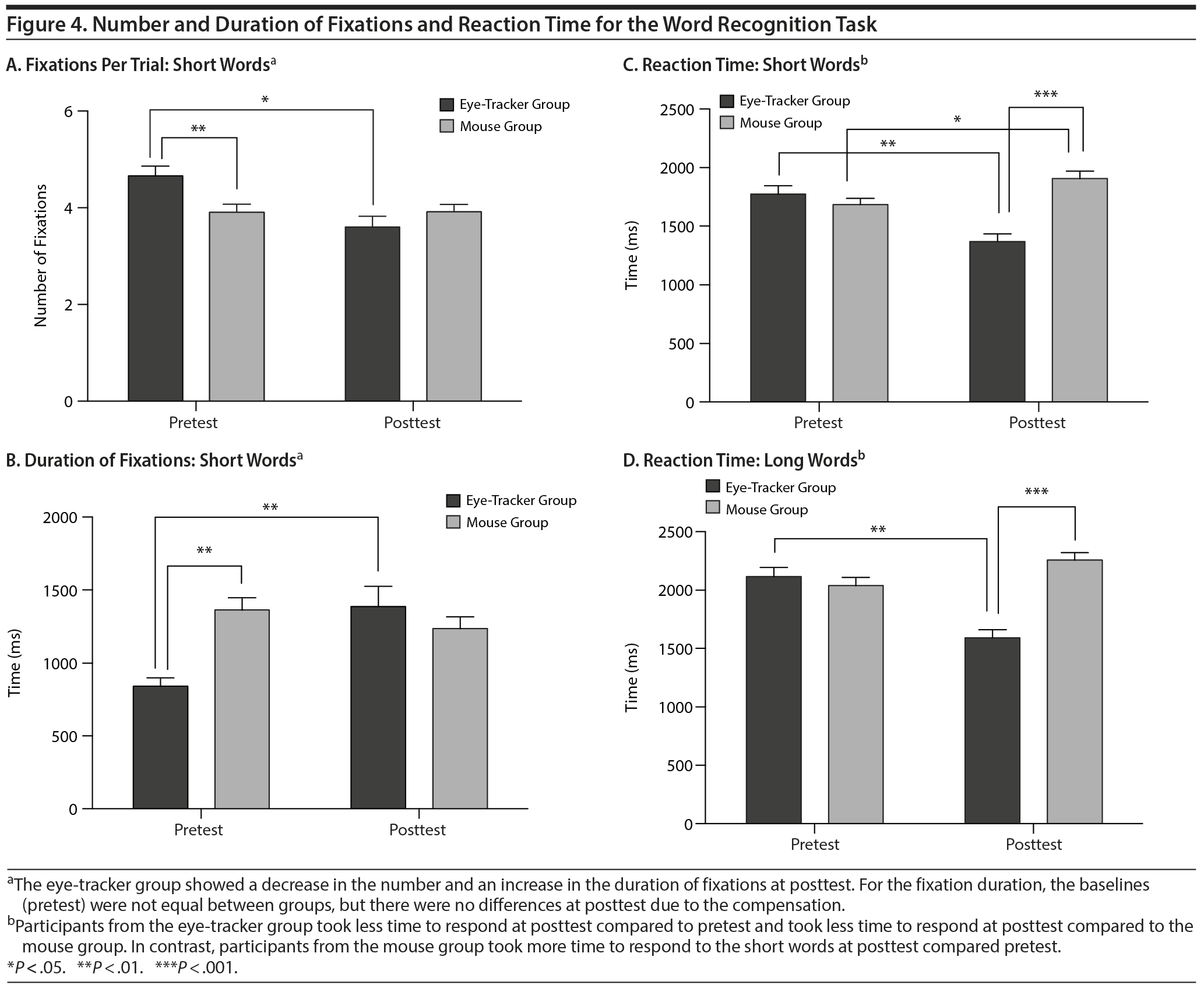
Reaction time was also assessed for short and long words in the word recognition task. ANOVA analysis of short words showed differences in significant group and its interaction with time point factor (F1,579 = 9.717, P = .0019; F1,579 = 18.93, P = .0001, respectively). Post hoc analysis revealed differences at posttest, with the eye-tracker group demonstrating a faster response compared to the mouse group (P < .0001). Post hoc analysis also showed differences between pretest and posttest in both the eye-tracker and mouse groups. Whereas a decrease in posttest reaction time compared to pretesting was found in the eye-tracker group (P < .01), an increase was found in the mouse group (P < .05) (4C).
ANOVA analysis of long words showed differences in significant group and its interaction with time point (F1,582 = 12.47, P = .0004; F1,582 = 19.82, P = .0001). Post hoc analysis showed differences at posttest, with the eye-tracker group demonstrating a faster response compared to the mouse group (P < .0001). Additionally, there was a decrease in posttest reaction time compared to pretesting in the eye-tracker group (P < .01), while there were no differences in the mouse group (Figure 4D).
We also assessed whether the comorbidity condition (presence or absence of dyslexia) or age (< 12 and ≥ 12 years) affected the group results. ANOVA analysis of impulsivity (F1,24 = 0.25, P = .619), reaction time in frog task (F1,219 = 1.425, P = .23), reaction time in word recognition task (F1,174 = 0.2325, P = .63), number of fixations in frog task (F1,38 = 0.2357, P = .627), and number of fixations in word recognition task (F1,181 = 0.069, P = .791) showed no significant differences due to the comorbidity condition. Likewise, age appears not to have an effect, as the ANOVA analyses of impulsivity (F1,24 = 0.2515, P = .62), reaction time in frog task (F1,219 = 1.255, P = .26), reaction time in word recognition task (F1,174 = 1.245, P = .266), number of fixations in frog task (F1,38 = 0.4186, P = .518), and number of fixations in word recognition task (F1,181 = 1.725, P = .19) showed no significant differences.
Usability and Enjoyability of the Game
The majority of children < 12 years of age enjoyed the game (78%). They tended to find the difficulty (66%) and challenge (44%) appropriate. Children ≥ 12 years of age did not enjoy the game (50%) or had no specific opinion about enjoyability (40%). They rated the game as not difficult (60%) or challenging (60%, Table 1).
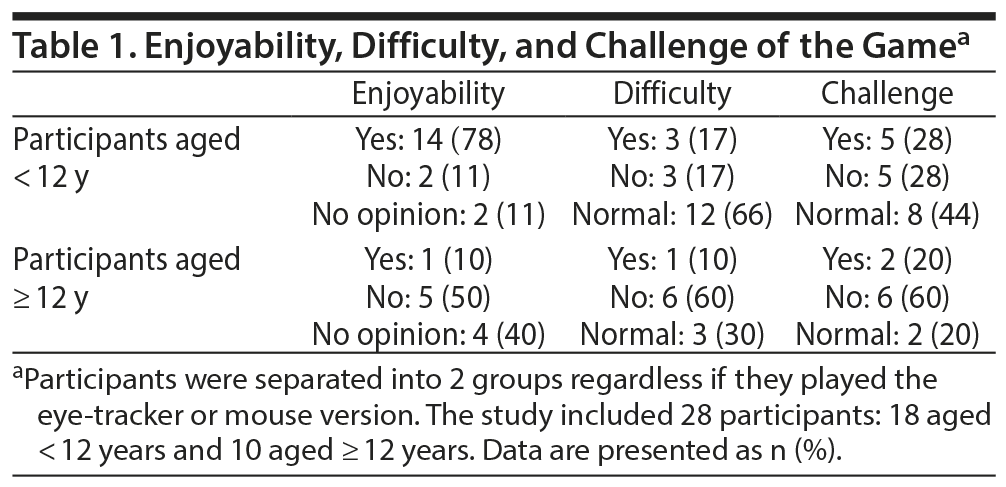
DISCUSSION
This study examined the efficacy of a novel attention training game, RECOGNeyes, for improving attention in a population of children with ADHD. A comparison of the experimental group and the active control group before and after the training reveals several significant effects. For the frog task, following training the experimental group, but not the control group, demonstrated reduced impulsivity, a reduction in the number of fixations, and an increase in the duration of fixations. For the word recognition task, following training the experimental group, but not the control group, demonstrated a reduction in reaction time for long and short words, an increase in the duration of fixations, and a decrease in the number of fixations. These results suggest that playing the eye-tracking version of RECOGNeyes, but not a modified mouse version of the game, can improve attention in a population of children with ADHD.
The differential improvement for the eye-tracking but not the mouse group suggests that the gaze-contingent element of the training is a critical component for successfully training the attention system. This finding supports the theoretical rationale for the RECOGNeyes game. The other objective parameters (probability of ADHD and dyslexia, severity of ADHD and hyperactivity) assessed did not differ between the 2 groups. These measures are based on eye vergence movements,18 which are not specifically trained by playing the RECOGNeyes game.
In general, ADHD patients have poor eye control. Hoffman19 suggests that there is a link between the oculomotor dysfunctions and the attention and learning abilities. It has been reported that ADHD patients have more difficulty suppressing saccadic eye movements when fixation is required.20,21 We found that children with ADHD who have played the eye-tracking version of the game had fewer saccadic movements, ie, reduced impulsivity compared to those who played the mouse version of the game. This improvement in the frog game could be because of the training by the game to suppress saccadic eye movements. In line with the saccadic behavior, the number of gaze fixations in both the frog task and word recognition task (for short words) decreased in the eye-tracker group but not in the mouse group. Similarly, the fixation duration increased in the eye-tracker group but not in the mouse group for both tasks.
ADHD patients have decreased levels of catecholamines (dopamine and norepinephrine) in the prefrontal cortex (PFC). Feifel et al22 observed that abnormalities in the PFC present in children with ADHD relate to the difficulty of inhibiting saccadic movements and may underlie the ADHD symptoms of inattention. Catecholamines are known to have an effect on the ocular motor pathways.23 Depletion of dopamine and norepinephrine increases the amplitude and frequency of saccadic eye movements during fixation. The increase in saccadic intrusions implies that catecholamines modulate the activity of a subpopulation of suppressor motor neurons in the human brainstem.24 Our observation of stronger saccadic suppression may suggest an improved modulatory effect of catecholamines in the eye-tracking group. Training the oculomotor control using an interactive eye-tracking game may thus improve inhibitory control by the PFC.
After the training sessions, participants from the eye-tracker group were faster in detecting the targets, whereas participants from the mouse group showed no improvement in detection performance. In both groups, the number of errors (commissions and omissions) did not change after training. Thus, participants who trained their oculomotor system were able to fixate longer on the target, which led to an improvement of their behavioral performance, ie, reaction time. Subsequent longer fixation could lead to better perceptual processing of the target information, which would enable participants to react faster. Although participants in the mouse group played the same game, they did not improve on the frog and word recognition tasks. Training the oculomotor system is apparently essential to improve behavior and requires real-time feedback on eye position. Our results may explain why other mouse-controlled video games have not been shown to be efficient in ADHD treatment.25 These games do not provide feedback needed to train the oculomotor system promoting the improvement of the attention visual system.
Adherence is important for any therapy to succeed. As an alternative therapy, eye-tracking videogames need to be engaging. According to outcomes on enjoyability and usability, the RECOGNeyes game may be more suitable for children < 12 years old, as they found the game enjoyable and not difficult but challenging. The children ≥ 12 years of age did not find the game very interesting, which may affect the training outcome. A more appropriate version of the game should be developed to engage these older children.
Our findings should be considered within the context of several limitations. There were some differences between the experimental group and the active control group in the baseline number and duration of fixations in the short word task. This difference may have enhanced the observed effect. Moreover, participants played the game for only 3 weeks. Further longitudinal studies in which the game is played for a longer period of time with larger samples are needed to confirm the alterations in behavior, apart from the oculomotor behavior.
CONCLUSIONS
The RECOGNeyes game trains the oculomotor visual system of ADHD patients, reducing the saccadic movements and improving gaze fixation and thereby reducing symptoms of impulsivity. RECOGNeyes may thus provide new insights into the treatment of ADHD.
Submitted: January 8, 2019; accepted April 25, 2019.
Published online: July 3, 2019.
Potential conflicts of interest: Ms García-Baos and Dr Supèr are both affiliated with Braingaze SL. Ms García-Baos received a small monthly fee from Braingaze SL for carrying out the study. Mr D’Amelio; Mss Oliveira and Echevarria; and Drs Collins, Zapata, and Liddle report no conflicts of interest related to the subject of this article.
Funding/support: None.
REFERENCES
1. Thomas R, Sanders S, Doust J, et al. Prevalence of attention-deficit/hyperactivity disorder: a systematic review and meta-analysis. Pediatrics. 2015;135(4):e994–e1001. PubMed CrossRef
2. National Institute of Mental Health. Attention deficit hyperactivity disorder. NIMH website. https://www.nimh.nih.gov/health/topics/attention-deficit-hyperactivity-disorder-adhd/index.shtml. Accessed June 7, 2019.
3. National Collaborating Centre for Mental Health (UK). Attention Deficit Hyperactivity Disorder: Diagnosis and Management of ADHD in Children, Young People and Adults, NICE Guideline, No 87. Leicester, UK: British Psychological Society; 2018.
4. Castellanos FX, Tannock R. Neuroscience of attention-deficit/hyperactivity disorder: the search for endophenotypes. Nat Rev Neurosci. 2002;3(8):617–628. PubMed CrossRef
5. Castellanos FX, Elia J, Kruesi MJ, et al. Cerebrospinal fluid homovanillic acid predicts behavioral response to stimulants in 45 boys with attention deficit/hyperactivity disorder. Neuropsychopharmacology. 1996;14(2):125–137. PubMed CrossRef
6. Michelson D, Faries D, Wernicke J, et al; Atomoxetine ADHD Study Group. Atomoxetine in the treatment of children and adolescents with attention-deficit/hyperactivity disorder: a randomized, placebo-controlled, dose-response study. Pediatrics. 2001;108(5):E83. PubMed CrossRef
7. Quintero J, Ramos-Quiroga JA, Sebastián JS, et al. Health care and societal costs of the management of children and adolescents with attention-deficit/hyperactivity disorder in Spain: a descriptive analysis. BMC Psychiatry. 2018;18(1):40. PubMed CrossRef
8. Connor DF, Fletcher KE, Swanson JM. A meta-analysis of clonidine for symptoms of attention-deficit hyperactivity disorder. J Am Acad Child Adolesc Psychiatry. 1999;38(12):1551–1559. PubMed CrossRef
9. Boonstra AM, Kooij JJS, Oosterlaan J, et al. Does methylphenidate improve inhibition and other cognitive abilities in adults with childhood-onset ADHD? J Clin Exp Neuropsychol. 2005;27(3):278–298. PubMed CrossRef
10. Mataix-Cols D, Marks IM. Self-help with minimal therapist contact for obsessive-compulsive disorder: a review. Eur Psychiatry. 2006;21(2):75–80. PubMed CrossRef
11. Bellack AS, Dickinson D, Morris SE, et al. The development of a computer-assisted cognitive remediation program for patients with schizophrenia. Isr J Psychiatry Relat Sci. 2005;42(1):5–14. PubMed
12. Carrard I, Fernandez-Aranda F, Lam T, et al. Evaluation of a guided internet self-treatment programme for bulimia nervosa in several European countries. Eur Eat Disord Rev. 2011;19(2):138–149. PubMed CrossRef
13. Lee J-H, Kwon H, Choi J, et al. Cue-exposure therapy to decrease alcohol craving in virtual environment. Cyberpsychol Behav. 2007;10(5):617–623. PubMed CrossRef
14. Difede J, Cukor J, Jayasinghe N, et al. Virtual reality exposure therapy for the treatment of posttraumatic stress disorder following September 11, 2001. J Clin Psychiatry. 2007;68(11):1639–1647. PubMed
15. Walshe DG, Lewis EJ, Kim SI, et al. Exploring the use of computer games and virtual reality in exposure therapy for fear of driving following a motor vehicle accident. Cyberpsychol Behav. 2003;6(3):329–334. PubMed CrossRef
16. Arns M, de Ridder S, Strehl U, et al. Efficacy of neurofeedback treatment in ADHD: the effects on inattention, impulsivity and hyperactivity: a meta-analysis. Clin EEG Neurosci. 2009;40(3):180–189. PubMed CrossRef
17. Liddle E. RECOGNeyes – CANDALight. University of Nottingham website. http://blogs.nottingham.ac.uk/candal/2017/06/15/recogneyes/. Accessed June 7, 2019.
18. Varela P, Lorena Esposito F, Morata I, et al. Clinical validation of eye vergence as an objective marker for diagnosis of attention deficit hyperactivity disorder in children. J Atten Disord. 2019;23(6):599–614. CrossRef
19. Hoffman LG. Incidence of vision difficulties in children with learning disabilities. J Am Optom Assoc. 1980;51(5):447–451. PubMed
20. Karatekin C, Asarnow RF. Exploratory eye movements to pictures in childhood-onset schizophrenia and attention-deficit/hyperactivity disorder (ADHD). J Abnorm Child Psychol. 1999;27(1):35–49. PubMed CrossRef
21. Munoz DP, Armstrong IT, Hampton KA, et al. Altered control of visual fixation and saccadic eye movements in attention-deficit hyperactivity disorder. J Neurophysiol. 2003;90(1):503–514. PubMed CrossRef
22. Feifel D, Farber RH, Clementz BA, et al. Inhibitory deficits in ocular motor behavior in adults with attention-deficit/hyperactivity disorder. Biol Psychiatry. 2004;56(5):333–339. PubMed CrossRef
23. Berridge CW, Devilbiss DM. Psychostimulants as cognitive enhancers: the prefrontal cortex, catecholamines, and attention-deficit/hyperactivity disorder. Biol Psychiatry. 2011;69(12):e101–e111. PubMed CrossRef
24. Tychsen L, Sitaram N. Catecholamine depletion produces irrepressible saccadic eye movements in normal humans. Ann Neurol. 1989;25(5):444–449. PubMed CrossRef
25. Bikic A, Christensen TØ, Leckman JF, et al. A double-blind randomized pilot trial comparing computerized cognitive exercises to Tetris in adolescents with attention-deficit/hyperactivity disorder. Nord J Psychiatry. 2017;71(6):455–464. PubMed CrossRef
Please sign in or purchase this PDF for $40.00.





